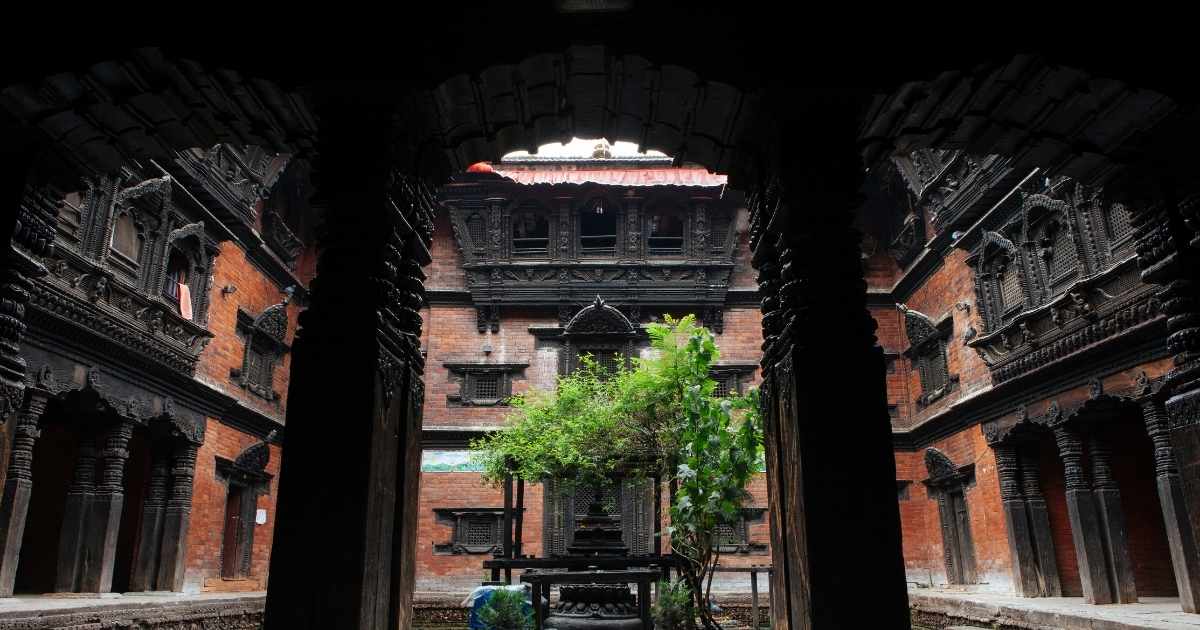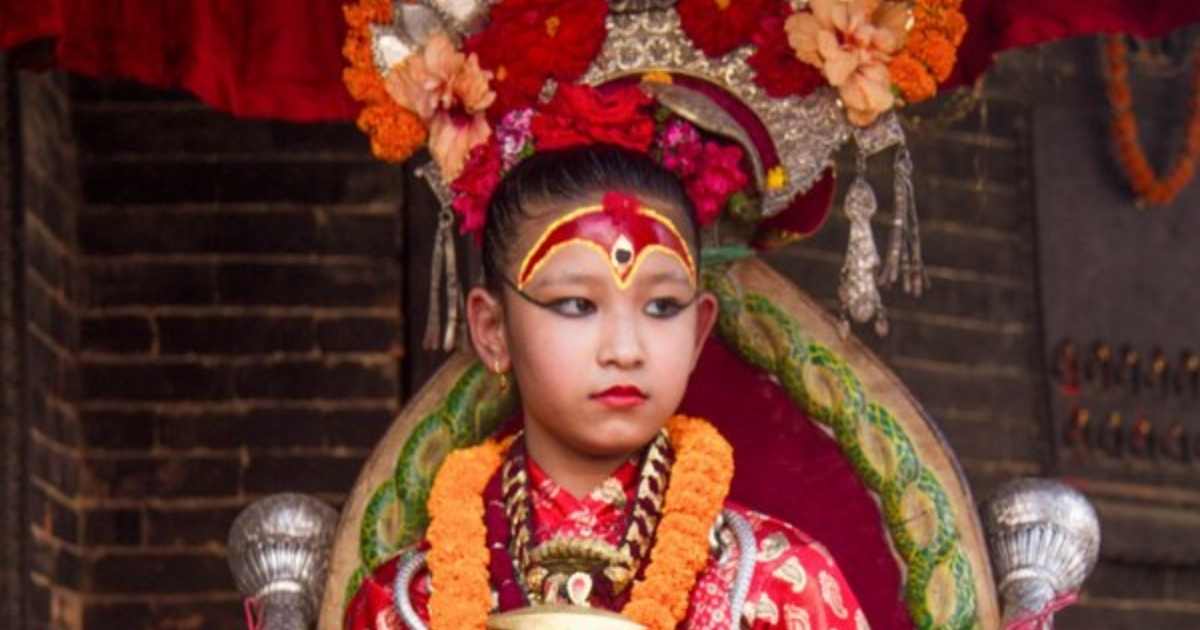
The Living Goddess of Nepal

The Living Goddess of Nepal
swotah travel
3644
01, 09 2022
The Kumari – All You Need to Know
When you think about must-sees in Kathmandu, I'm sure your mind doesn’t turn to see real living gods and goddesses!
But did you know Nepal has living goddesses? In fact, the Kathmandu Valley has four of them in Kathmandu Patan, Bhaktapur, and Bungamati. The most well-known Kumari is probably the one situated in Kathmandu Durbar Square, which you may have an opportunity to see during one of your multi-day tours of Nepal during some religious festivals when she is brought out of her home. But how can there be living goddesses today? What is the meaning and history behind them? Read on!
Living Goddess
The Kumari, or Living Durga, is a virgin girl who manifests the divine female Devi. The name Kumari comes from Sanskrit, meaning princess. But she is much more than a princess.
The Kumari is believed to be the reincarnation of Taleju, a manifestation of the goddess Durga. The Kumari is a prepubescent girl selected from the Shakya caste of the Newari Buddhist community and worshipped by Hindus.
But How Did this Practise Begin?
Worship of virgins appears to have been taking place in Nepal for more than 2,000 years, yet the worship of a living Kumari dates only from the 17th century. Naturally, there are many legends regarding the start of this tradition. Interestingly, most of the legends involve one king in particular, with the most popular being that King Jayaprakash Malla (the last of the Malla Kings who ruled from the 12th – 17th century) began playing a dice game every evening in his chambers with the goddess Taleju. Taleju had sworn the king to secrecy – no one should know she came nightly to play dice. However, one night the king’s wife entered the chamber and saw Tajeju. This made the goddess angry, who said if the king wanted her to continue to protect his country, he would have to search for her among the Newari (Shakya) community. She stated she would be incarnated as a little girl in that community. This led to the king's search for the young girl who possessed Taleju’s spirit.

Photo: kumari bahal (home of kumari)
How do they select the Kumari, and How Long Does She Remain Kumari?
Let me answer the second part of the question first. The young girl selected to be Kumari remains a goddess until her first period or has some serious illness or accident in which her blood is spilled. At this point, the Taleju leaves the sitting Kumari, and a successor must be found.
So, how do they go about selecting the next Kumari? The Newar Shakya caste’s traditional trade is silver and goldsmiths. The search begins there. The girl must be in excellent health, having never had a disease or shed blood. She also should not have blemishes (i.e., birthmarks) or have lost her teeth. These are the basic requirements. Then comes the harder stuff. Now she must pass the Battis Lakshana or thirty-two perfections required by a goddess. Seemingly, a goddess must have:
A neck like a conch shell
A body like a banyan tree
Eyelashes like a cow
Thighs like a deer
Chest like a lion
Voice soft and clear as a duck's
And also, very black eyes and hair, with small hands and feet and a full set of 20 teeth.
The girl’s horoscope is read – it is important it complements the king’s. Although since there is no longer a king in Nepal, I don’t know whose horoscope it must compliment! Her family is also closely looked at.
Having gotten this far, there are more tests to ensure she is fearless. Remember, the girl is probably around 4 or 5 years old when all this is happening… her next test takes place during Dashain when 108 buffaloes and goats are sacrificed to the goddess Kali. The potential Kumari is taken to the Taleju temple, with severed animal heads and blood scattered around. In the candlelight,, this must be quite terrifying, especially when masked dances are roaming around. If she shows no fear, she is considered to have the qualities of Taleju. If she shows fear, the next candidate is brought in to experience this strange ritual.
But it doesn’t end there. The next test consists of spending the night alone among the heads of the goats and buffaloes without showing fear. If she passes this test, she must be able to pick out the personal belongings of the previous Kumari. She is truly the goddess if she can recognize these items among an array of other items!
Purification and Looking Like a Goddess
Now she has been chosen, there are purifying rites to go through to cleanse her of her past experiences. Dressed with the Kumari's traditional makeup, she enters her new home. The place which she will live in for the duration of her time as a goddess. Her family is only allowed to visit rarely, and she can only play with a selected few children. She always wears the red and gold of the Kumari and has an agni chakshu (fire eye) painted on the forehead.

Pic: Kumari with traditional Makeup
What Happens Next?
She will never wear shoes, nor will her feet touch the ground outside of the Kumari house. She is expected to be serene always – a bad-tempered goddess is a bad omen.
She has some ceremonial duties, including receiving people, government officials, and the sick. Her reactions to the visitors are watched closely as it is believed that how she responds predicts their future lives. For example, if she does the following, the meaning is clear:-
Crying or loud laughter: serious illness or death
Weeping or rubbing eyes: imminent death
Trembling: imprisonment
Hand clapping: reason to fear the king (or whoever it is nowadays)
Picking at food offerings: financial losses
If the Kumari remains silent and impassive throughout the audience, this is a sign that the visitors’ wishes have been granted.
Since even a glimpse of the Kumari is seen to be very fortunate, crowds of people wait below her window. There is more opportunity to see her when she is paraded in her chariot during festivals. Ask your Nepal tour agency to provide an easy walking tour of the Kumari house.
Other than her ‘official duties, ’ her life is quite simple. She does not have to do anything but is attended by the Kumarinmi, who attend to her every need. While they cannot order her to do anything, they must guide her through her goddess life. In the past, the Kumari was not educated – why would a goddess need that since she sees everything? But in more modern times, it has become necessary to attend school, so the transition back to a mortal life is less hard on the child. Some Kumari’s attend school while others, including the one in Kathmandu, have private tutors.
What Happens When She is No Longer a Kumari?
Once the girl reaches puberty, she is no longer considered Kumari and returns to her family and normal life. But as you can imagine, having been taken care of and lived this unique lifestyle since she was a very young child, it must be really hard to fit into normal society.
In the past, Kumaris did not marry as it was considered bad luck and most likely a death sentence for a man to marry an ex-goddess. Today that belief has gone, and most ex-Kumaris are married.
Ex-Kumari (of Patan) Chanira Bajracharya remembers how difficult it was to adjust to the real world when she turned 15. “I did not know how to join a conversation, could not understand how people behaved; everything was strange.”
Modern Times
I'm quite sure in the past, ex Kumari’s were never heard of outside their immediate community, but times change! Ex Kumari Rashmila Shakya has written an autobiography, “From Goddess to Mortal”,Vajra Publications, about her time as a goddess, which no doubt explains many myths and mysteries.
And some years ago Chanira was planning to form a support group for ex-Kumaris. I don’t know whether she achieved this or not. How strange to think goddesses need support groups just like us, mere mortals!
NEWSLETTER SIGNUP
Sign up to receive our trip ideas and travel offers!
Get updates and Exclusive Offers up to 20% Discount








